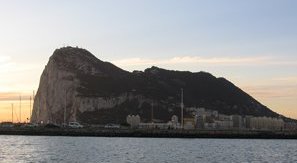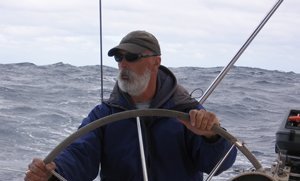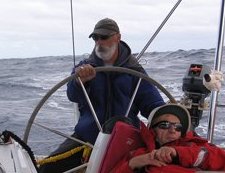Andy: Gibraltar to Las Palmas de Grand Canaria

|
28:07.679N
15:25.617W It’s now 8 days since we arrived in the Canary Islands
and already the memories of the tough journey down from Gibraltar are starting
to fade. Here at the marina, and in the city, it’s just so different
from our 7 day passage at sea. The hospitality and friendliness of the
local people (and the ARC organizing staff), the weather, the food, the
entertainment have been a delightful tonic to make us actually want to go back
to sea for another 3 weeks! Unbelievable. Because on the way down
there were times I’m sure when each of us privately thought what the heck
are we doing here and headed into. For me that was putting it mildly J We left the harbor at Gibraltar Tuesday Nov 03 early in the
morning with a calm sea with a beautiful moon still hanging in the s ky around
‘The Rock’.
Some 720 nautical miles (1,350 Kilometers for the
landlubbers, or about Victoria to Edmonton) to our destination. Our first
task was to navigate out and through the Straits of Gibraltar which is very
much like Haro Strait only longer. Significant currents and wind to
contend with. And the geography is intimidating. Africa and a huge
continent beyond on the left (Morocco), and Europe and Asia on the right (Spain).
The sense of history as you sail those waters separating the Mediterranean
“Birth of Civilization Countries” from Africa, Europe and
America is impressive. And towards the end of the Strait on the Spanish
side is a very large, very old Roman lighthouse/guard tower standing over it
all reminding you of your somewhat small place in the scheme of history.
>From their, unfortunately, the seas and weather conspired against us. It could have been significantly worse, no question about
that. But it was certainly significantly uncomfortable. On the
second day the winds picked up into the 20-25 knots range and over the next 6
days grew steadily into the 25 to 30 range. With short half hour to one
hour increases into the 30-35 knots area, the maximum gust we saw was 38
knots. The seas picked up and I’m sure were best described by the
term ‘confused’, albeit again I’m sure it could have
been much, much worse. Where you would like to have long, slow big
rolling waves we ended up for most of the time with relatively short high and
steep seas coming from different directions. Sometimes from the NE,
sometimes from N, then over to ENE. And all at the same time. “Wave?
What Wave?” The winds were behind us effectively all the way down so we had
to sail slightly off wind. And what all of that meant is the boat rolled,
yawed, rocked, rolled, surfed off the waves, got knocked to port or starboard
by waves and oh yes bounced up and down. For those of you who
have sailed in the Strait of Georgia in rough weather, or Strait of Juan de
Fuca think about the ugly days you were out there. Then take those 4 to 6
hour crossings and do it for 6 days. Add in wave hights of 2-3 and likely
3-5 meters with short wave periods and you will have a pretty good idea
of how it felt. We did get one or two rain squalls go over us, and
several waves splashed off the sides of the boat and drenched us as the wind
picked it up off the splash and blew it in our faces but for the most part it
was dry. And fairly warm unlike the cold of the pacific northwest rough
weather. Captain Ron
asks that age old question: “Brian, Brian are you sure we go
right, I mean starboard, I mean thataway ?” To which Brian
dutifully responds: “Sure, Whatever”. Andy risks getting thrown
overboard for compromising and insensitive photo taking opportunities.
Now in fairness, sailing stories are a lot like fishing
stories. I’m sure I make it bigger each time I tell it.
But those are my memories of the crossing. At the same time there were
short 30 minute periods when the sailing was just wonderful. The wind
would stabilize at 18-20 knots, the waves would turn into big but long, rolling
swells all from the same direction off the port or starboard quarter, the boat
would be well balanced sail wise and easy to steer and you could clip along as
though you were on the interstate (in boat speeds for us that was 6.5 to 7.5
knots). Many of you know I take blood thinner medication (Warfarin
aka Cumoden), and I think taking rat poison on a boat at sea might be a fitting
allusion for my journey to this point, but suffice to say by the time we
arrived I was black and blue all over. I’m in the V-Berth at the
bow for sleeping and even their I think I picked up bruises bouncing around
regardless of how well I wedged myself in with luggage, baggage and
pillows. On shore and in the showers/swimming pool afterwards I’m
sure some people thought I had lost a battle and maybe the war with my calm
quite gentle significant other J
Four of us brought the boat to the Canaries. Ron,
Brian, Dave and myself. We ran two watches of two people and our watch
schedule was 6, 6, 5, 4, 3. Which means that Ron and Brian took the first
watch from 6:00 am to Noon. Then Dave and I took second shift Noon to 6:00
pm. Then Brian-Ron 6:00 pm to 11:00 pm, followed by Dave-Andy 11:00
pm to 3:00 am and finally Ron-Brian 3:00 am to 6:00 am. At that point you
keep alternating the sequence for the second day but you are now on the
opposite set of watches. It worked quite well because in the heavy
weather you needed two people on watch both alternating steering and trimming
sail occasionally. It was hard work on the wheel in those conditions and
we all tired quickly. With the strain of the sleeping pattern change, getting
sleep in those conditions and using a lot of energy just moving about the boat
in rough seas we all tired quickly. But credit to us, our spirits
remained strong and upbeat and we never once took out our anxieties and/or
frustrations on each other. And as I write this it occurs the boat
performed pretty well too. Some minor breakdowns but nothing major.
We broke our main sail furling line to the cockpit, but could still reef/furl
the main by going up on deck. Certainly a challenge and inconvenient but
quite manageable. We forget to turn off the water maker once so ended up
with water sloshing around in the head. As soon as we realized the source
and emptied the bilge no problem. But at first you kind of go ..
hmmmm where’s this water coming from !!!??? Night sailing was in a good mix of variable
conditions. Some starlight sailing, some bright moon against puffy clouds
sailing, but mostly it was very dark with squalls and showers around.
I’ve always been a “steer by the horizon or sighting” skipper
with occasional glances at the compass to maintain the correct course. At
night, with no horizons, you really do have to steer by compass alone otherwise
you do a drunken sailor dance along your track. Many thanks to Dave for
showing me tips and techniques on how to do (sail by compass alone) that.
I think I’m reasonably proficient at it now and it’s certainly a
skill that will come in very handy in the future. Very, very different
that steering under power in calm seas. And finally landfall in the Canaries. The seas were
large and sloppy to the end but after rounding the breakwater at about 9:00 AM
Monday morning everything started to look up.
Well enough of the preparation journey. As I said at
the start all is well. The wind and wave forecasts and expectations for
the big crossing are much more promising. Kevin, the fifth crew member,
joined us last night and Myles will join us on Thursday. Anticipation and
excitement are rising and we all feel fit and ready to go on! Silly
really, isn’t it ? J The
bright and positive side is that perhaps we have the worst behind us, and at
the very least we know we can handle the tough stuff which in itself if very
comforting. More later from yours truly. Andy (On board Erasmos Tuesday Nov 17th, 7:00
AM) |




